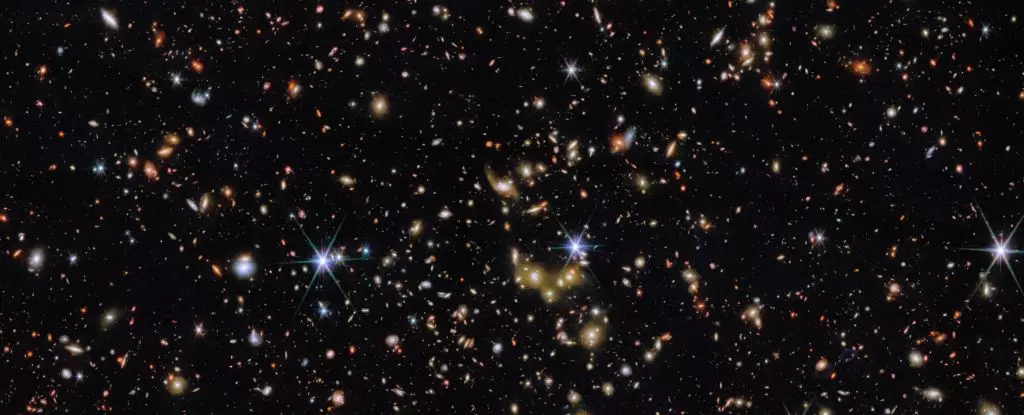In a realm where our imagination often falters, the James Webb Space Telescope (JWST) delivers a breathtaking glimpse into the abyss of the cosmos. By capturing images of a seemingly inconspicuous patch of sky, less than a fifth the width of a full Moon, JWST invites us to explore ideas far beyond our earthly experiences. The latest spectacular image showcased the staggering depth and richness of the universe, where a plethora of galaxies silently glimmer, echoing secrets from nearly 12 billion years ago. It’s an experience that feels both humbling and enlightening, dragging us into the profound unknown of space-time.
What makes this image particularly fascinating is its ability to juxtapose the familiar with the extraordinary. Observing the night sky from Earth can be a calming experience, but the panorama revealed by the JWST flips that notion on its head. Instead of merely gazing at bright stars, we are confronted with a myriad of galaxies—vast cosmic cities filled with untold stories, all residing within a tiny portion of the universe. Such an observation emphasizes not only the vastness of space but also the intricate tapestry of cosmic evolution that has occurred over billions of years.
Diffraction Patterns and Celestial Clarity
A delightful feature of the JWST images is its diffraction spikes—the pointy patterns seen in bright stars, a unique hallmark of the telescope’s design. As light from these concentrated points bend, they create a distinctive representation that separates stars from galaxies in the image. This contrasts brilliantly with the more diffuse light emitted by galaxies, which lacks such sharp features. The delineation of stars against a backdrop of galaxies provides not just clarity but also an entry point into understanding celestial structures.
In this cosmic portrait, one can observe a group of stellar bodies radiating with a golden light, with their light journeying across the void of space for an astonishing 6.5 billion years. Such a staggering time frame reminds us of our planet’s fleeting presence in the grand scheme of the universe. The ability to identify and connect with such distant objects lends poignancy to our own existence, revealing how connected we are to the expansive and ancient cosmic landscape.
The Search for Cosmic Connectivity
The observations were part of the COSMOS-Web survey—an ambitious project aimed at cataloging galaxies that shed light on the universe’s evolution. It underscores a fundamental truth: the arrangement of galaxies is not random. Rather, they congregate in clusters, intricately connected by an enigmatic cosmic web of dark matter and hydrogen. This web is the backbone of the universe, holding together vast clusters of galaxies, while also hinting at the unseen forces at play in the cosmos.
The fusion of JWST’s data with X-ray observations from the Chandra X-ray Observatory paints an even larger picture of these galaxies. The collaboration underscores a monumental aspect of astronomy: the concept of observing multiple wavelengths to glean a comprehensive understanding of cosmic structures. The glowing hot gas suffusing galaxy clusters adds another layer of depth to our understanding, as the intense glow detectable in X-radiation showcases the cluster’s immense scale and power.
The Profound Potential of Our Universe
Additionally, the catalog compiled from this survey by an international team led by astrophysicist Greta Toni presents a staggering statistic—1,678 identified groups of galaxies in a mere 6.44 by 6.44 arcminute area. This isn’t just about individual galaxies; it highlights the intricate relationships formed in vast groupings. With our best telescopes, we realize that every tiny patch of the sky may host countless galaxies yet to be discovered, each contributing to the cosmic narrative shaping the universe’s history.
What lies beyond this singular patch of sky is equally thrilling: the potential for even more cosmic discoveries lurking in areas smaller than your pinky nail. As we expand our observational capabilities, the possibility that other tiny regions are equally saturated with galaxies excites the imagination, pushing our boundaries of what we consider knowable.
The wonder of these findings ignites a passion within us to delve deeper, to uncover the mysteries underlying the fabric of space-time. Each discovery serves as a beacon of inspiration, reminding us that the universe remains an open book, waiting for the curious minds to explore its infinite pages. With instruments like the JWST, exploring the cosmos is no longer an abstract concept; it’s an exhilarating journey into realms we have only begun to fathom.


Leave a Reply